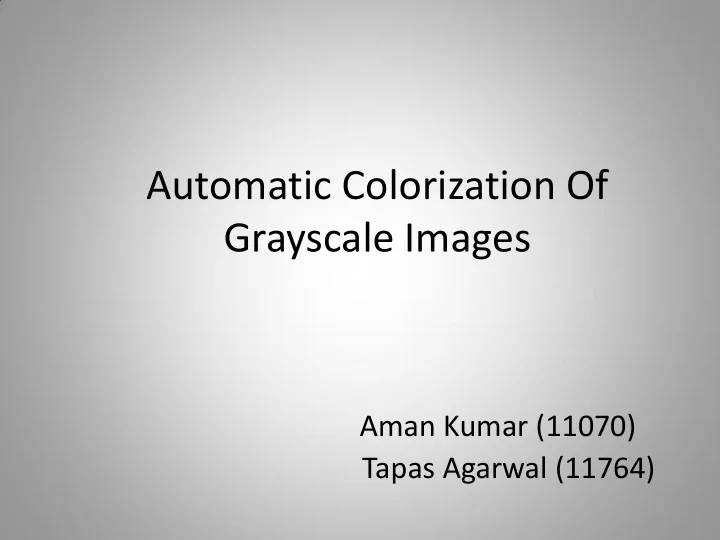

Automatic Colorization Of Grayscale Images Aman Kumar (11070) Tapas Agarwal (11764)
Problem and Motivation • Given one or more gray-scale image(s) , we want to automatically colorize it using a similar colored image (provided by the user). • The application of such method is in colorization of old photographs & cinemas, IR images, CCTV cameras, astronomical photography, etc.
YUV Color space • In this problem, instead of working in RGB color space we will use YUV color space. • In YUV space , Y stands for Luminance component of image (gray scale part of the image). • U and V are Chrominance component of the Y image. • This is an advantage for this problem as we already have Luminance part (Y) in the target U image. Hence we only need to determine (U, V) components. V Source : Wikipedia
Our Approach The approach consists of the following main conceptual stages: • Segmentation of reference image. • Training based on feature vector and labelled segment of reference image. • Segmentation of target image and its classification based on above trained model. • Colorization using optimized method.
Segmentation • Image segmentation is done on the Luminance (Y) channel of the reference image. • Since the target image (only having Y) is also to be segmented. Source: Reference 1
Feature Descriptor • For a reliable classification, training must be based on texture feature of the reference image. • We will use the Discrete Cosine Transform(DCT) coefficients of a k by k neighbourhood around the pixel as its feature vector ( dimension k*k) • DCT feature are known to be better texture descriptors which are invariant to Translation and Rotation.
Training Stage • Intra-difference : difference between vectors of similar segments. • Inter-difference: difference between vectors of different segments. • Our classifier must ignore Intra-difference between vectors and must decide on basis of inter-difference.
Training And Classification • We use PCA and Projections. • Randomly sample intra-different vectors, apply PCA , keep eigenvectors corresponding to Low values (minimizing intra-difference) • Randomly sample inter-different vectors, apply PCA , keep eigenvectors corresponding to High values. (maximizing inter-difference) • Project data points onto above space and Use K Nearest Neighbour during classification.
Image Space Voting • There can still be many misclassification . A pixel p in target image, may be surrounded by pixels of different classes. • To rectify this we replace the label of p with dominant label in N(p). Where N(p) is k*k neighbourhood of p. • Dominant label is label with highest confidence , conf(p ,l) . Source : reference 1 • Here , D is Euclidian distance between feature vectors and M q is nearest neighbour of vector q in feature space.
Colorization • Let C(p) be the Chrominance coordinate (U,V) of a pixel p. • After Classification each p in target image, the color of p (with label l ) is given by Source: reference 1
Optimization • Since there might be some misclassifications , hence assigning colors to all pixels using above method will not be correct. • We only assign colors to the pixels whose confidence in their label is sufficiently large ( conf (p ,l) > threshold ) . • This process is called “micro - scribbling”.
Optimization • Colorization using Optimization by Anat Levin et al (2004), describes method to colorize gray scale images annotated by user. Source: reference 2 • We feed our “micro - scribbled” image this L evin’s algorithm for better results.
Dataset • We will use Local IITK copy of Berkeley Segmentation Dataset BSD 300 http://web.cse.iitk.ac.in/users/cs676/data/BSDS300-images.tgz • It contains test and training data of similar images. • We will also collect some similar images manually.
Overview of the method Source: reference 1
Till Now Source of colored images : Berkeley Segmentation Dataset BSD 300 We have segmented the images and obtained the Texture feature vectors of the reference and target image in 5x5 neighbourhood of a pixel.
References 1. Colorization by Example, R.Irony, D.CohenOr, and D.Lischinski, Eurographics symposiu m on Rendering (2005) 2. Colorization using Optimization, - Anat Levin, D.Lischinski, Yair Weiss,SIGGRA(2004) 3. Determination of Number of Clusters in K-Means Clustering and Application in Colour Image Segmentation Siddheswar Ray and Rose H. Turi (1999) 4. Patch based Image Colorization. - A Bugeau and V T Ta. Pattern Recognition (ICPR), 2012. 5. Code for colorization using optimization [2] available at: http://www.cs.huji.ac.il/~yweiss/Colorization/
Any Questions ?
Algorithm Of Colorization Using Optimization • This method colorizes user provided annotated gray-scale image or a video clip with few annotated frames. • Y(r) , U(r) , V(r) denote YUV component of pixel (r) at (x,y) at time t. • Colorization of a pixel r is transformed into minimization of following quantity. Source: reference 2
Recommend
More recommend